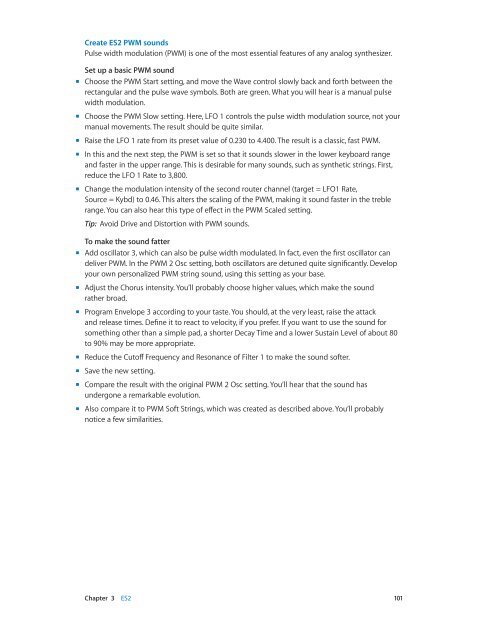Apple MainStage 3 Instruments - MainStage 3 Instruments
Apple MainStage 3 Instruments - MainStage 3 Instruments
Apple MainStage 3 Instruments - MainStage 3 Instruments
You also want an ePaper? Increase the reach of your titles
YUMPU automatically turns print PDFs into web optimized ePapers that Google loves.
Create ES2 PWM sounds<br />
Pulse width modulation (PWM) is one of the most essential features of any analog synthesizer.<br />
Set up a basic PWM sound<br />
mm<br />
Choose the PWM Start setting, and move the Wave control slowly back and forth between the<br />
rectangular and the pulse wave symbols. Both are green. What you will hear is a manual pulse<br />
width modulation.<br />
mm<br />
Choose the PWM Slow setting. Here, LFO 1 controls the pulse width modulation source, not your<br />
manual movements. The result should be quite similar.<br />
mm<br />
Raise the LFO 1 rate from its preset value of 0.230 to 4.400. The result is a classic, fast PWM.<br />
mm<br />
In this and the next step, the PWM is set so that it sounds slower in the lower keyboard range<br />
and faster in the upper range. This is desirable for many sounds, such as synthetic strings. First,<br />
reduce the LFO 1 Rate to 3,800.<br />
mm<br />
Change the modulation intensity of the second router channel (target = LFO1 Rate,<br />
Source = Kybd) to 0.46. This alters the scaling of the PWM, making it sound faster in the treble<br />
range. You can also hear this type of effect in the PWM Scaled setting.<br />
Tip: Avoid Drive and Distortion with PWM sounds.<br />
To make the sound fatter<br />
mm<br />
Add oscillator 3, which can also be pulse width modulated. In fact, even the first oscillator can<br />
deliver PWM. In the PWM 2 Osc setting, both oscillators are detuned quite significantly. Develop<br />
your own personalized PWM string sound, using this setting as your base.<br />
mm<br />
Adjust the Chorus intensity. You’ll probably choose higher values, which make the sound<br />
rather broad.<br />
mm<br />
Program Envelope 3 according to your taste. You should, at the very least, raise the attack<br />
and release times. Define it to react to velocity, if you prefer. If you want to use the sound for<br />
something other than a simple pad, a shorter Decay Time and a lower Sustain Level of about 80<br />
to 90% may be more appropriate.<br />
mm<br />
Reduce the Cutoff Frequency and Resonance of Filter 1 to make the sound softer.<br />
mm<br />
Save the new setting.<br />
mm<br />
Compare the result with the original PWM 2 Osc setting. You’ll hear that the sound has<br />
undergone a remarkable evolution.<br />
mm<br />
Also compare it to PWM Soft Strings, which was created as described above. You’ll probably<br />
notice a few similarities.<br />
Chapter 3 ES2 101
















